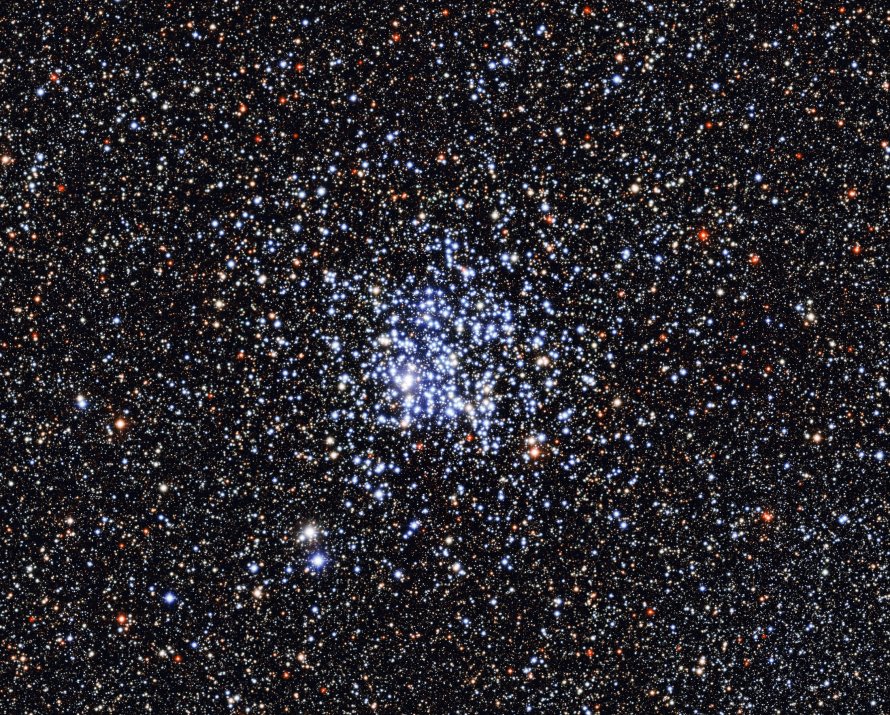M11 (NGC 6705) - Wild Duck Cluster
Messier 11 (NGC 6705), also known as the Wild Duck Cluster, is an open cluster located in the constellation Scutum, in the Sagittarius Arm of the Milky Way Galaxy in the Local Group of galaxies. M11 is 6200 light years away from Earth.
M11 is best viewed during late summer, is magnitude 5.8, and can be viewed with naked eye (barely). M11 is 23' in apparent size. For reference, the full moon is 30'.
Observing difficulty: Easy
- Name:
- Wild Duck Cluster
- Type:
- open cluster
- Constellation:
- Scutum
- NGC or IC:
- NGC 6705
- Magnitude:
- 5.8
- Viewing:
- naked eye (barely)
- Size:
- 23'
- Distance (light years):
- 6200 LY
- RA:
- 18h 51.1m
- Dec:
- -6 16'
- Season:
- late summer
- Milky Way location:
- Sagittarius Arm
- Galaxy group:
- Local Group
- Messier Marathon #:
- 88
- Contains:
- 3,000 stars
* The naked eye can see up to magnitude ~7-8 objects under ideal dark sky conditions.
Unraveling the Secrets of the Wild Duck Cluster
From the perspective of an amateur astronomer, Messier 11 (M11), known as the Wild Duck Cluster, is a fascinating open cluster teeming with intriguing characteristics. Located in the constellation Scutum, M11 showcases the spectacle of star formation and evolution with exceptional beauty. This article explores the discovery, physical traits, stellar population, and brightness of M11, as well as its location in the night sky and observation guidelines.
Discovery and Observation
M11 was initially discovered by German astronomer Gottfried Kirch in 1681 and later cataloged by Charles Messier in 1764. Situated around 6,200 light-years from Earth, this cluster, under the right conditions, is a treat to the naked eye and a marvel when observed with a small telescope. Its resemblance to a flock of ducks in flight led to its popular name, the Wild Duck Cluster.
Physical Characteristics and Magnitude
M11 spans about 19 light-years across, with a much denser core region extending roughly 3 light-years. This cluster is characterized by a relatively high density, unusual for an open cluster, with an estimated 2,900 stars. The Wild Duck Cluster shines with an apparent magnitude of 6.3, making it one of the brightest open clusters in the night sky and a great target for amateur astronomers.
Stellar Composition
M11 is considered an intermediate-age cluster at around 220 million years old. Its starry residents represent a wide range of spectral types, with B-type and A-type main sequence stars being the most prevalent. The cluster also hosts several red giants, with the brightest being an orange-hued K-type giant. These stars largely share a metallicity equivalent to our Sun, suggesting similar stellar composition.
Evolutionary Significance
One fascinating feature of M11 is its evolutionary state. As an open cluster housing a substantial number of evolved, post-main sequence stars, the Wild Duck Cluster provides a snapshot of stellar evolution within a relatively dense environment. The existence of numerous yellow and red giant stars indicates that a significant fraction of the cluster's population has already exhausted their hydrogen fuel and transitioned off the main sequence.
Finding and Viewing M11
For observers in the Northern Hemisphere, M11 is an easily accessible summer object located in the constellation Scutum. The cluster can be found just north-east of the star Gamma Scuti. Even a modest telescope can resolve many of the cluster's stars, creating a spectacular view. M11's relatively high brightness and concentrated core make it a satisfying target for amateur astrophotography and visual observation alike.



